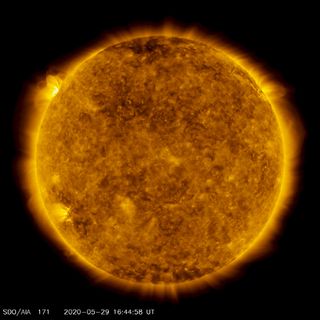Sun unleashes biggest flare since 2017.
Is our star waking up?

On the upper left side of this image from May 29, 2020, from NASA's Solar Dynamics Observatory — shown here in the 171-angstrom wavelength, which is typically colorized in gold — one can see a spot of light hovering above the left horizon. This light emanates from solar material tracing out magnetic field lines that are hovering over a set of sunspots about to rotate over the left limb of the sun.(Image: © NASA/Solar Dynamics Observatory/Joy Ng)
The sun may be coming out of its slumber at long last.
This morning (May 29), our star fired off its strongest flare since October 2017, an eruption spotted by NASA's sun-watching Solar Dynamics Observatory (SDO).
Solar flares are bursts of radiation that originate from sunspots, temporary dark and relatively cool patches on the solar surface that boast very strong magnetic fields. Scientists classify strong flares into three categories: C, M and X. Each class is 10 times more powerful than the one beneath it; M flares are 10 times stronger than C flares, but 10 times weaker
lumber at long last.
This morning (May 29), our star fired off its strongest flare since October 2017, an eruption spotted by NASA's sun-watching Solar Dynamics Observatory (SDO).
Solar flares are bursts of radiation that originate from sunspots, temporary dark and relatively cool patches on the solar surface that boast very strong magnetic fields. Scientists classify strong flares into three categories: C, M and X. Each class is 10 times more powerful than the one beneath it; M flares are 10 times stronger than C flares, but 10 times weaker



No comments:
Post a Comment